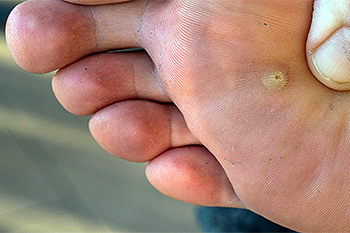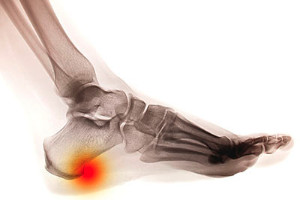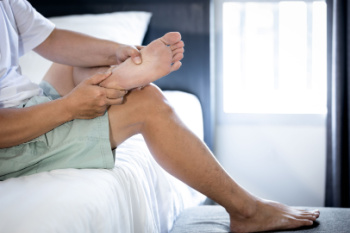Connect With Us
Blog
Items filtered by date: July 2024
What Are Plantar Warts?

Plantar warts are small growths caused by the human papillomavirus, or HPV, that typically develop on the soles of the feet. They often appear as rough, grainy lesions with tiny black dots, which are clotted blood vessels. Symptoms can include discomfort or pain when walking or standing, especially if the wart is located over a weight-bearing area like the heel or ball of the foot. Plantar warts spread through direct contact with the virus, thriving in warm, moist environments like communal showers or swimming pools. The virus can enter the body through small cuts or breaks in the skin. Individuals with weakened immune systems or who walk barefoot in public places are more susceptible. If you have developed a plantar wart, it is suggested that you consult a podiatrist who can effectively treat this condition, which often includes in-office treatment.
Plantar warts can be very uncomfortable. If you need your feet checked, contact Dr. David Ungar from Personal Foot Care. Our doctor will assist you with all of your foot and ankle needs.
About Plantar Warts
Plantar warts are the result of HPV, or human papillomavirus, getting into open wounds on the feet. They are mostly found on the heels or balls of the feet.
While plantar warts are generally harmless, those experiencing excessive pain or those suffering from diabetes or a compromised immune system require immediate medical care. Plantar warts are easily diagnosed, usually through scraping off a bit of rough skin or by getting a biopsy.
Symptoms
- Lesions on the bottom of your feet, usually rough and grainy
- Hard or thick callused spots
- Wart seeds, which are small clotted blood vessels that look like little black spots
- Pain, discomfort, or tenderness of your feet when walking or standing
Treatment
- Freezing
- Electric tool removal
- Laser Treatment
- Topical Creams (prescription only)
- Over-the-counter medications
To help prevent developing plantar warts, avoid walking barefoot over abrasive surfaces that can cause cuts or wounds for HPV to get into. Avoiding direct contact with other warts, as well as not picking or rubbing existing warts, can help prevent the further spread of plantar warts. However, if you think you have developed plantar warts, speak to your podiatrist. He or she can diagnose the warts on your feet and recommend the appropriate treatment options.
If you have any questions please feel free to contact our office located in Farmington, MI . We offer the newest diagnostic and treatment technologies for all your foot and ankle needs.
Types of Broken Toes and Relief Options

Diagnosing a broken toe involves recognizing symptoms such as intense pain, swelling, bruising, and difficulty walking. Types of toe fractures include stress fractures, where small cracks form from repetitive stress, and traumatic fractures, resulting from a direct blow or impact. A doctor will perform a physical examination and may order X-rays to confirm the diagnosis and determine the fracture type. Relief options for a broken toe include rest and elevation to reduce swelling and pain. Depending on the type of fracture, buddy-taping the injured toe to an adjacent toe may provide support and alignment during healing. Wearing stiff-soled shoes can protect the toe and ease walking. In severe cases, a cast or surgery may be necessary to ensure proper healing. If you have fractured your toe, it is suggested that you consult a podiatrist who can guide you toward a comprehensive treatment plan.
Broken toes may cause a lot of pain and should be treated as soon as possible. If you have any concerns about your feet, contact Dr. David Ungar from Personal Foot Care. Our doctor will treat your foot and ankle needs.
What Is a Broken Toe?
A broken toe occurs when one or more of the toe bones of the foot are broken after an injury. Injuries such as stubbing your toe or dropping a heavy object on it may cause a toe fracture.
Symptoms of a Broken Toe
- Swelling
- Pain (with/without wearing shoes)
- Stiffness
- Nail Injury
Although the injured toe should be monitored daily, it is especially important to have a podiatrist look at your toe if you have severe symptoms. Some of these symptoms include worsening or new pain that is not relieved with medication, sores, redness, or open wounds near the toe.
If you have any questions, please feel free to contact our office located in Farmington, MI . We offer the newest diagnostic and treatment technologies for all your foot care needs.
Causes and Prevention of Heel Spurs

Heel spurs are calcium deposits that develop on the underside of the heel bone, often without causing any discomfort. However, when the plantar fascia ligament, which connects the heel to the toes, undergoes excessive tension or strain, it can become inflamed. This may lead to a condition known as plantar fasciitis, which can cause the heel spur to press into the swollen ligament and cause significant pain. While heel spurs themselves are generally painless, they frequently accompany plantar fasciitis, with about 70 percent of cases showing the presence of a heel spur. Preventative measures include wearing shoes with proper arch support, using heel pads, maintaining a healthy weight, and performing calf stretches before engaging in strenuous activities. A podiatrist can provide a comprehensive treatment plan tailored to your specific needs, which may include custom orthotics, physical therapy, and recommendations for supportive footwear. Surgery may be needed to address severe cases, though it carries risks such as increased pain, nerve damage, and fallen arches. If you are experiencing heel pain, it is suggested that you make an appointment with a podiatrist for an exam and treatment.
Heel spurs can be incredibly painful and sometimes may make you unable to participate in physical activities. To get medical care for your heel spurs, contact Dr. David Ungar from Personal Foot Care. Our doctor will do everything possible to treat your condition.
Heels Spurs
Heel spurs are formed by calcium deposits on the back of the foot where the heel is. This can also be caused by small fragments of bone breaking off one section of the foot, attaching onto the back of the foot. Heel spurs can also be bone growth on the back of the foot and may grow in the direction of the arch of the foot.
Older individuals usually suffer from heel spurs and pain sometimes intensifies with age. One of the main condition's spurs are related to is plantar fasciitis.
Pain
The pain associated with spurs is often because of weight placed on the feet. When someone is walking, their entire weight is concentrated on the feet. Bone spurs then have the tendency to affect other bones and tissues around the foot. As the pain continues, the feet will become tender and sensitive over time.
Treatments
There are many ways to treat heel spurs. If one is suffering from heel spurs in conjunction with pain, there are several methods for healing. Medication, surgery, and herbal care are some options.
If you have any questions feel free to contact our office located in Farmington, MI . We offer the latest in diagnostic and treatment technology to meet your needs.
Are Bunions Affecting Your Everyday Life?
Possible Causes of Foot Pain
 Foot pain is a common issue that can arise from various causes, impacting daily activities and overall quality of life. The most common causes include plantar fasciitis, which involves inflammation of the tissue running along the bottom of the foot, and arthritis, which affects the joints. Other frequent sources of foot pain are bunions, caused by misalignment of the big toe joint, and hammertoes, where toes bend abnormally. Injuries such as fractures, sprains, and strains also contribute to foot pain, often resulting from accidents or overuse. Additionally, deformities like flat feet or high arches can lead to discomfort by altering the natural distribution of weight across the foot. Conditions such as tendinitis and neuropathy, particularly in individuals with diabetes, can further contribute to foot pain. Treatment varies depending on the cause but typically includes rest, anti-inflammatory medications, and wearing proper footwear. Stretching exercises and orthotic devices can also help alleviate pain. For persistent or severe foot pain, it is suggested that you consult a podiatrist for a comprehensive diagnosis and tailored treatment plan.
Foot pain is a common issue that can arise from various causes, impacting daily activities and overall quality of life. The most common causes include plantar fasciitis, which involves inflammation of the tissue running along the bottom of the foot, and arthritis, which affects the joints. Other frequent sources of foot pain are bunions, caused by misalignment of the big toe joint, and hammertoes, where toes bend abnormally. Injuries such as fractures, sprains, and strains also contribute to foot pain, often resulting from accidents or overuse. Additionally, deformities like flat feet or high arches can lead to discomfort by altering the natural distribution of weight across the foot. Conditions such as tendinitis and neuropathy, particularly in individuals with diabetes, can further contribute to foot pain. Treatment varies depending on the cause but typically includes rest, anti-inflammatory medications, and wearing proper footwear. Stretching exercises and orthotic devices can also help alleviate pain. For persistent or severe foot pain, it is suggested that you consult a podiatrist for a comprehensive diagnosis and tailored treatment plan.
Foot Pain
Foot pain can be extremely painful and debilitating. If you have a foot pain, consult with Dr. David Ungar from Personal Foot Care. Our doctor will assess your condition and provide you with quality foot and ankle treatment.
Causes
Foot pain is a very broad condition that could be caused by one or more ailments. The most common include:
- Bunions
- Hammertoes
- Plantar Fasciitis
- Bone Spurs
- Corns
- Tarsal Tunnel Syndrome
- Ingrown Toenails
- Arthritis (such as Gout, Rheumatoid, and Osteoarthritis)
- Flat Feet
- Injury (from stress fractures, broken toe, foot, ankle, Achilles tendon ruptures, and sprains)
- And more
Diagnosis
To figure out the cause of foot pain, podiatrists utilize several different methods. This can range from simple visual inspections and sensation tests to X-rays and MRI scans. Prior medical history, family medical history, and any recent physical traumatic events will all be taken into consideration for a proper diagnosis.
Treatment
Treatment depends upon the cause of the foot pain. Whether it is resting, staying off the foot, or having surgery; podiatrists have a number of treatment options available for foot pain.
If you have any questions, please feel free to contact our office located in Farmington, MI . We offer the newest diagnostic and treatment technologies for all your foot care needs.
Potential Foot Ailments During Pregnancy

Pregnancy brings numerous changes to a woman's body, often leading to foot problems. One of the most common issues is flat feet, or overpronation, where increased body weight causes the foot arch to flatten and the feet to roll inward. This can result in pain and additional strain on the feet, calves, and back. Wearing supportive footwear and using orthotics can help alleviate this discomfort. Swelling, or edema, typical in the second or third trimester, results from increased blood volume and pressure, leading to water retention in the legs and feet. Regular movement, elevating the feet, staying hydrated, and reducing salt intake can help reduce swelling. Pregnant women are also prone to developing ingrown toenails due to changes in foot size and shape, often worsened by tighter shoes. Soaking feet in salt water and having toenails properly trimmed can offer relief. Additionally, some women experience hot or burning sensations in their feet due to hormonal changes and increased body temperature. Cracked heels might develop from the added weight and posture changes that cause dry skin and heel expansion. Moisturizing and wearing comfortable shoes can prevent and treat these cracks. If you are experiencing foot pain during pregnancy, it is suggested that you schedule an appointment with a podiatrist for an exam and appropriate treatment.
Pregnant women with swollen feet can be treated with a variety of different methods that are readily available. For more information about other cures for swollen feet during pregnancy, consult with Dr. David Ungar from Personal Foot Care. Our doctor will attend to all of your foot and ankle needs.
What Foot Problems Can Arise During Pregnancy?
One problem that can occur is overpronation, which occurs when the arch of the foot flattens and tends to roll inward. This can cause pain and discomfort in your heels while you’re walking or even just standing up, trying to support your baby.
Another problem is edema, or swelling in the extremities. This often affects the feet during pregnancy but tends to occur in the later stages.
How Can I Keep My Feet Healthy During Pregnancy?
- Wearing orthotics can provide extra support for the feet and help distribute weight evenly
- Minimize the amount of time spent walking barefoot
- Wear shoes with good arch support
- Wear shoes that allow for good circulation to the feet
- Elevate feet if you experience swelling
- Massage your feet
- Get regular, light exercise, such as walking, to promote blood circulation to the feet
If you have any questions please feel free to contact our office located in Farmington, MI . We offer the newest diagnostic and treatment technologies for all your foot and ankle needs.

